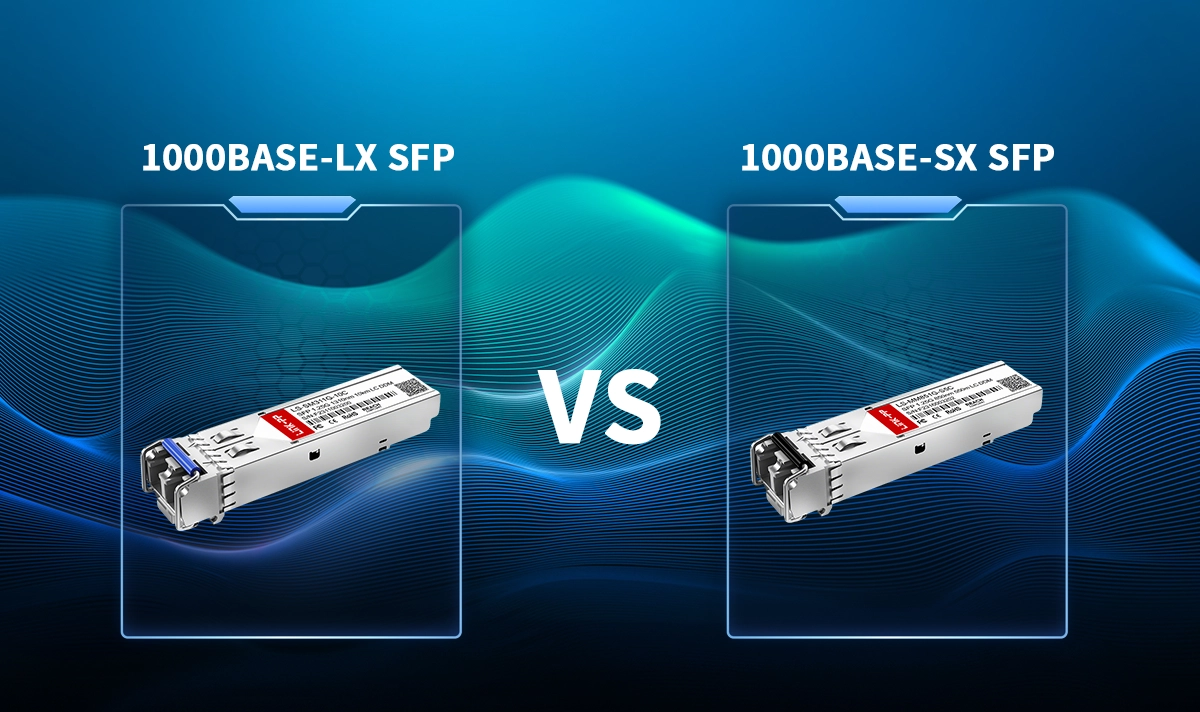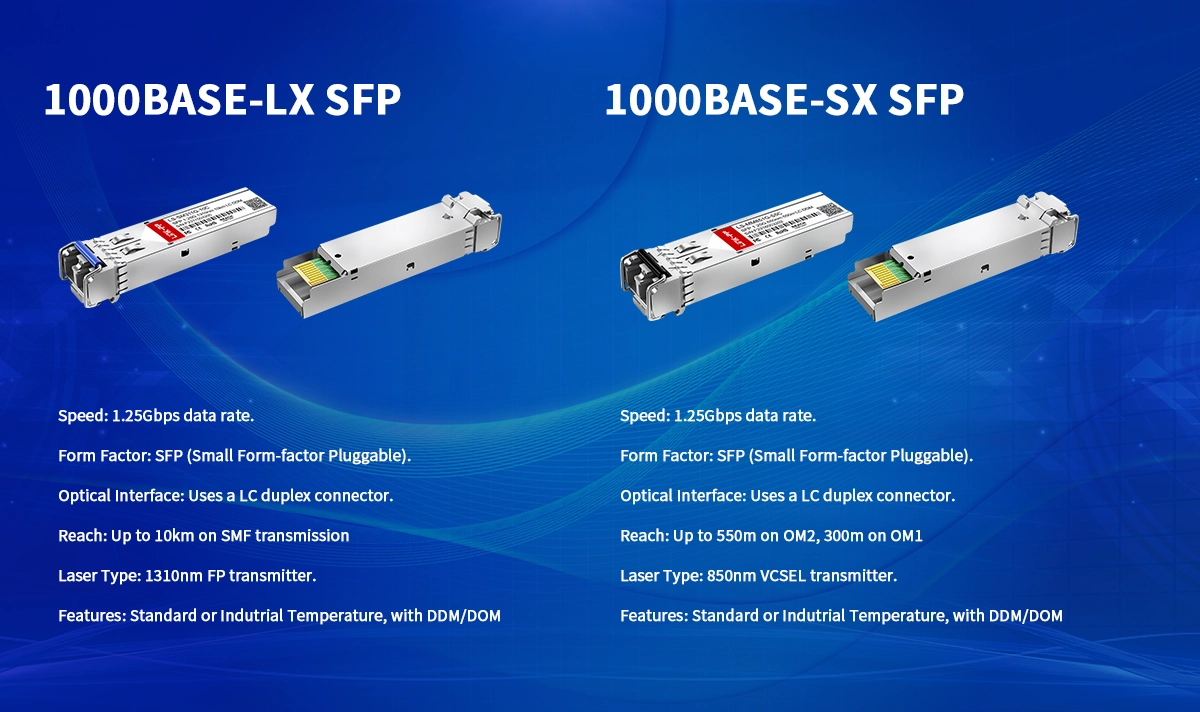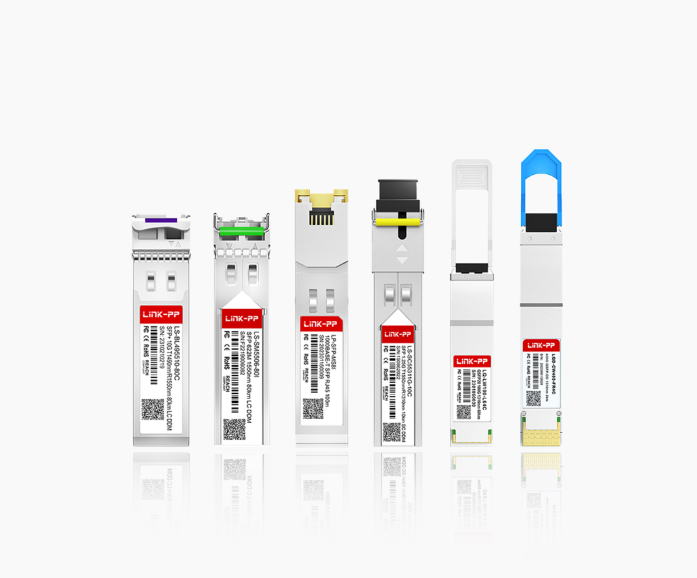
In the world of Gigabit Ethernet over fiber optics, choosing between 1000BASE-LX and 1000BASE-SX SFP transceivers is a critical decision impacting network performance, cost, and scalability. While both deliver 1 Gbps speeds, their underlying technologies and ideal use cases differ significantly. Selecting the wrong optical module can lead to compatibility headaches, unnecessary expenses, or failed links. This guide dives deep into the LX vs SX SFP, empowering you to make an informed choice for your specific infrastructure needs. We'll also highlight reliable, high-performance LINK-PP SFP modules designed for seamless integration.
➢ Key Takeaways
1000BASE-SX SFP works well with multimode fiber for short distances up to 550 meters. This makes it a good choice for local networks and data centers because it saves money.
1000BASE-LX SFP uses single-mode fiber to send data as far as 10 kilometers. This is great for linking buildings or big campus networks.
Always pick the right SFP transceiver for your fiber type and distance. This helps your network stay fast and reliable.
Keep fiber connectors clean and check if parts work together before you install them. This helps stop connection problems and keeps your network running.
Follow the right steps when installing and watch your equipment’s temperature. This helps your network stay strong and stable.
➢ Understanding the Core Technology: Wavelength & Fiber Type
The fundamental difference lies in the laser wavelength and the type of optical fiber they are designed to use:
1000BASE-SX SFP (Short Wavelength):
Wavelength: 850nm.
Fiber Type: Primarily designed for Multimode Fiber (MMF), specifically OM1, OM2, OM3, and OM4. Uses cheaper Vertical-Cavity Surface-Emitting Lasers (VCSELs).
Core Concept: Optimized for shorter distances within buildings or campuses. Leverages the lower cost of MMF and 850nm optics. Crucial for multimode fiber applications.
1000BASE-LX SFP (Long Wavelength):
Wavelength: 1310nm.
Fiber Type: Designed for both Single-Mode Fiber (SMF) and, with mode-conditioning patch cables (MCP), longer distances on Multimode Fiber (MMF). Uses more expensive Fabry-Perot (FP) or Distributed Feedback (DFB) lasers.
Core Concept: Optimized for longer distances, especially over SMF. Offers greater flexibility in fiber plant usage. Essential for long distance SFP links and single mode fiber optic modules.
➢ What is the Difference Between 1000BASE-LX and 1000BASE-SX SFP

This table summarizes the critical distinctions:
Feature | 1000BASE-SX SFP | 1000BASE-LX SFP |
|---|---|---|
Wavelength | 850nm | 1310nm |
Primary Fiber | Multimode Fiber (OM1/OM2/OM3/OM4) | Single-Mode Fiber (SMF) & MMF (with MCP) |
Max Distance | OM1: 300m | SMF: 10km+ (standard) |
Laser Type | VCSEL (Lower Cost) | FP/DFB Laser (Higher Cost) |
Relative Cost | Lower Cost SFP | Higher Cost |
Typical Use | Data center SFP, LAN backbone, intra-building links, server-to-switch | Campus backbone, MAN links, building-to-building, long distance SFP runs, future-proofing for SMF upgrades |
Key Advantage | Cost-effective for short MMF runs | Long distance, fiber type flexibility |
➢ Choosing the Right Module: Application Scenarios
Choose 1000BASE-SX SFP When:
Your links are under 550 meters (especially within a single data hall or building).
You are exclusively using Multimode Fiber (OM3/OM4 recommended for best performance/distance).
Cost optimization is a primary concern for high-density deployments (e.g., top-of-rack switching).
You need standard Gigabit SFP modules for data center SFP interconnects or server access.
Choose 1000BASE-LX SFP When:
Your links exceed 550 meters, especially reaching kilometers.
Your infrastructure uses Single-Mode Fiber (SMF), the standard for long-haul and future-proofing.
You have a mix of MMF and SMF in your plant and need SFP compatibility across different segments (using MCP for MMF links).
You require long distance SFP capabilities for campus or metro-area connectivity.
You prioritize investment in a fiber type (SMF) designed for future 10G, 40G, 100G, and beyond upgrades.
➢ LINK-PP: Your Trusted Source for High-Performance SFP Modules
Ensuring SFP compatibility and reliable performance is non-negotiable. LINK-PP manufactures rigorously tested, MSA-compliant optical transceivers that deliver exceptional value and seamless integration with major switch brands (Cisco, Juniper, HPE, Arista, Brocade, etc.).
For 1000BASE-SX Needs: Consider the LINK-PP LS-MM851G-S5C. This high-quality, cost-effective multimode SFP delivers robust performance over OM1, OM2, OM3, and OM4 fiber up to 550m. Perfect for data center SFP deployments and low cost SFP requirements without sacrificing reliability. (Keywords: gigabit multimode transceiver, SX SFP module, 850nm SFP)
For 1000BASE-LX Needs: The LINK-PP LS-SM311G-10C is an excellent choice. This versatile single mode fiber optic module achieves the standard 10km over SMF. It can also operate over MMF up to 550m (OM1/OM2) or 220m (OM3/OM4) using a mode conditioning cable, offering exceptional flexibility. Ideal for long distance SFP links and future-proof networks. (Keywords: LX SFP module, 1310nm SFP, 10km SFP, single mode SFP, mode conditioning patch cable)
Why Compatibility & Quality Matter
Using genuine or high-quality MSA-compliant third-party optical modules like those from LINK-PP ensures:
Reliability: Stable links and reduced downtime.
Interoperability: Seamless function with your existing switches and routers.
Cost Savings: Significant savings compared to OEM modules.
Performance: Meets or exceeds IEEE 802.3z specifications for gigabit SFP modules.
Ready to optimize your fiber network cost-effectively? Browse our full range of certified LINK-PP 1000BASE-SX and 1000BASE-LX SFP modules today and find the perfect fit! [Explore LINK-PP SFP Modules]
➢ Conclusion: Matching the Module to Your Fiber Plant
The choice between 1000BASE-LX and 1000BASE-SX SFP transceivers boils down to two key factors: distance requirements and fiber optic cable type.
Short distances (<550m) on Multimode Fiber? 1000BASE-SX is the clear lower cost SFP winner, ideal for data center SFP and LAN applications. The LINK-PP LS-MM851G-S5C provides reliable, affordable performance.
Long distances (km+) or Single-Mode Fiber? 1000BASE-LX is essential, offering superior reach and SMF compatibility. It's also your go-to if you need flexibility across mixed fiber types. The LINK-PP LS-SM311G-10C delivers dependable long distance SFP connectivity.
Understanding these core differences – wavelength, fiber type support, distance capabilities, and cost – empowers you to select the optical module for every link in your network, ensuring performance, reliability, and cost-efficiency. Always verify compatibility with your specific switch model and invest in quality optical modules from trusted suppliers like LINK-PP to safeguard your network investment.
Still unsure which SFP module is right for your specific fiber run? Contact our LINK-PP technical support experts for personalized advice and ensure seamless compatibility! Get SFP Selection Help ➞
➢ FAQ
What is the main difference between 1000base-sx sfp and 1000base-lx sfp?
The 1000base-sx sfp uses an 850nm wavelength. It works for short distances with multimode fiber. The 1000base-lx sfp uses a 1310nm wavelength. It is made for long distances with single-mode fiber. Each one supports different distances and uses.
Can I use 1000base-lx sfp in my existing multimode fiber network?
Yes, you can use 1000base-lx sfp with multimode fiber cables. You need a mode conditioning patch cord for this to work well. This helps your network stay fast and reliable. Always check your fiber and connector before you install any optical transceiver.
Which SFP should I choose for high-speed networks in data centres?
If your fiber runs are short, use 1000base-sx sfp in data centers. For longer distances or to connect buildings, pick 1000base-lx sfp. It gives better reach and strong data for big networks.
How does the distance capability affect network performance?
Distance capability tells you how far data can go without problems. If you pick the right transceiver for your fiber and distance, your data stays safe and fast. Using the wrong SFP can make your network slow or weak.




